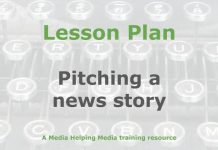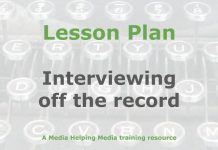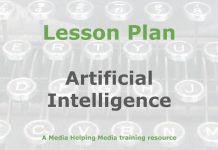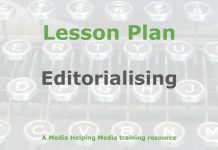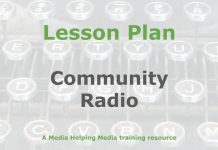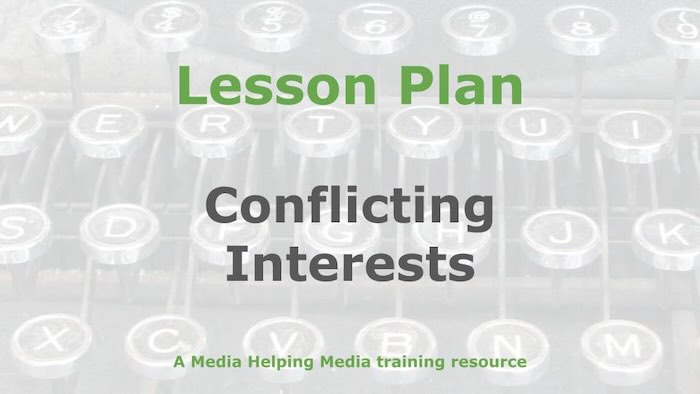 This lesson plan emphasises the importance of understanding, identifying, and avoiding journalistic conflicts of interest in order to maintain editorial integrity and public trust.
This lesson plan emphasises the importance of understanding, identifying, and avoiding journalistic conflicts of interest in order to maintain editorial integrity and public trust.
It’s based on the article ‘Conflicts of interest‘ which is published on Media Helping Media and which we recommend you read before adapting this lesson plan for your own purposes.
Learning Objectives
- Define and recognise conflicts of interest in journalism.
- Understand why conflicts of interest undermine journalistic integrity.
- Identify real-world scenarios where conflicts may arise.
- Practise ethical decision-making and disclosure.
- Develop personal strategies for maintaining impartiality.
Session 1: Introduction to conflicts of interest (45 min)
- Focus:
- Define conflicts of interest.
- Discuss why they matter in journalism.
- Activities:
- Icebreaker discussion:
- Presentation: Overview of conflicts of interest, using examples such as writing for other organisations, political activities, financial interests, and personal relationships.
- Key points:
- Conflicts of interest include any situation where personal, commercial, business, or financial interests could influence editorial decisions. Even the perception of bias can damage public trust.
- Journalists must declare all potential conflicts to senior editorial managers.
Session 2: Recognising conflicts – case studies (1 hour)
- Focus:
-
- Identify conflicts of interest in real-world scenarios.
-
- Activities:
- Group work: Analyse short scenarios (provided by the instructor) based on real cases:
- Accepting gifts or hospitality from sources.
- Reporting on a relative or friend.
- Delivering media training to outside companies.
- Returning favours or giving in to demands.
- Writing for multiple news outlets.
- Group presentations: Each group explains whether a conflict exists and why.
- Group work: Analyse short scenarios (provided by the instructor) based on real cases:
- Discussion points:
- The importance of editorial independence and impartiality.
- How even well-intentioned actions can appear biased.
- Why transparency and disclosure are essential.
Session 3: Editorial integrity and impartiality (1 hour)
- Focus:
- Explore the link between conflicts of interest and journalistic integrity.
- Activities:
- Lecture: The role of integrity in journalism. Why journalists must not accept favours, bribes, or promises.
- Discussion: “Should journalists be allowed to campaign for causes they believe in?”
- Key takeaways:
- Journalists must not promote or endorse organisations, products, or causes in their reporting.
- Personal interests must never influence story choice or treatment.
- Editorial control must always remain with the journalist and their news organisation.
Session 4: Navigating Ethical Dilemmas (1 hour 15 min)
- Focus:
- Practise ethical decision-making and disclosure.
- Activities:
- Role-play scenarios:
- A journalist is asked to report on a charity they support personally.
- A reporter is offered a high fee to train politicians in media handling.
- A journalist learns their relative is at the centre of a breaking news story.
- Debrief: Groups discuss the best course of action for each scenario.
- Role-play scenarios:
- Guidance:
- Disclose conflicts to editors immediately.
- Step back from stories where impartiality is compromised.
- Maintain transparency with the public and within the newsroom.
Session 5: Building personal codes and newsroom policies (1 hour)
- Focus:
- Develop strategies for dealing with conflicts of interest.
- Activities:
- Workshop: Draft a personal code of conduct for handling conflicts.
- Group discussion: What policies should newsrooms have? (e.g., regular training, clear guidelines for accepting gifts or speaking engagements.
- Best practices:
- Declare all external relationships and interests to senior editorial staff.
- Avoid accepting money, gifts, or services in exchange for coverage.
- Work with a range of organisations, not favouring one above another.
Session 6: Reflection and Q&A (30 min)
- Focus:
- Reflect on lessons learned and clarify any remaining questions.
- Activities:
- Reflection: “What will you do differently as a result of today’s session?”
- Q&A: Open floor for questions on conflicts of interest.
Summary of key principles
- Conflicts of interest can be direct or perceived; both are damaging.
- Transparency and disclosure are non-negotiable.
- Editorial independence is the foundation of public trust.
- Journalists must always act in the public interest, not personal or commercial interests.
- Newsrooms should foster a culture of openness, regular training, and clear ethical guidelines.
Suggested materials and resources
- Printouts of case studies and scenarios.
- Handouts summarising newsroom policies on conflicts of interest.
- Copies of relevant sections from Media Helping Media’s guidance on ethics and ethical scenarios.
This lesson plan is rooted in the ethical guidance and real-world scenarios provided by Media Helping Media, ensuring aspiring journalists are equipped to recognise, disclose, and manage conflicts of interest in their professional lives so that their journalism isn’t compromised.
